Physical Address
304 North Cardinal St.
Dorchester Center, MA 02124
For the most part, consistency now exists in the terminology, definitions, and systems used for pathologic and clinical classification of breast disease. The World Health Organization (WHO), Royal College of Pathologists, College of American Pathologists (CAP), and European Commission have produced guidelines on reporting breast disease. These propose virtually identical systems of classification of benign conditions that pathologists are encouraged to adopt. Guidelines on the classification of malignant breast lesions and assessment of prognostic and predictive factors have also been produced that pathologists should follow. In this chapter we use and endorse these classifications.
Benign breast lesions are presented according to the major accepted groupings of fibrocystic change, fibroadenoma and variants, sclerosing lesions, papilloma and proliferative breast disease, and malignant epithelial tumors. These are described according to histologic subtype with additional details of prognostic and predictive factor assessment.
Fibrocystic change is the preferred term used by pathologists to note combinations of breast changes, including cyst formation, apocrine metaplasia, columnar cell change, and various forms of adenosis. Minor changes, including fibrosis, microcyst formation, lobular involution, and minor degrees of sclerosing adenosis or columnar cell change, should be regarded as variants of normality and classified as minimal alteration or “aberrations of normal development and involution.” The use of an umbrella category such as fibrocystic change, which covers a variety of alterations in the breast that may have differences in etiology or clinical relevance, is acceptable when a dominant distinct histologic process is not present.
After publication of retrospective studies of breast cancer risk related to benign breast disease, the importance of the presence of epithelial proliferation in association with fibrocystic change and other benign conditions, such as papillomas, has increasingly become recognized. The presence or absence of epithelial hyperplasia and its character is now regarded as a mandatory subclassification of fibrocystic change (see later discussion of proliferative breast disease).
In symptomatic breast practice, fibrocystic change usually presents as a mass of variable size that may be ill defined or well defined. Ultrasound and imaging investigations may reveal cyst formation and/or microcalcification. The entity is rare before the age of 25 years, and most patients are seen clinically between the ages of 35 and 50 years. Cyst formation occurs rarely after menopause.
No characteristic gross appearances of fibrocystic change are seen; in general, areas of breast involved by this process are ill defined and contain areas of firm, fibrofatty tissue and multiple cysts of varying size.
As defined earlier, fibrocystic change characteristically is a mixture of several benign entities that are dealt with individually as follows or elsewhere in this chapter.
Cysts are believed to arise from a process of lobular involution, with microcyst formation in lobular acini progressing through expansion or coalescence into macroscopic cysts. They are very common, occurring in 19% of the general population and being palpable in 7%. Management is usually by simple aspiration. The cyst fluid can be examined cytologically, although this is not worthwhile unless the fluid is bloodstained or a residual mass is present, as the incidence of papillary or intracystic carcinoma is very low in comparison with the frequency of symptomatic cysts. No association is known between single cysts and breast cancer.
Cysts may be single or multiple. They are rarely excised, exceptions being recurrent large cysts and multiple cysts causing disfigurement or discomfort or the presence of an intracystic lesion. Cysts are found incidentally in approximately 77% of cancer-bearing breasts. They vary in size, are rounded, and contain a range of fluid types from thin, clear, straw-colored fluid to thick, opaque, green or brown material.
Two main forms of cyst are recognized; those lined by a single layer of cuboidal ( Fig. 16.1 ) or flattened, attenuated epithelium and, more common, those lined by apocrine epithelium (see Fig. 16.1 ). This latter type of epithelium resembles normal apocrine sweat gland epithelium, the cells being large and columnar with abundant granular eosinophilic cytoplasm and usually basally positioned nuclei. The cytoplasm may protrude into the lumen in the form of apical snouts. The granules show Sudan black and periodic acid–Schiff (PAS) diastase-resistant positivity. The apocrine epithelial layer is usually single, but hyperplasia resulting in a papillary structure can occur. The significance of papillary apocrine change and apocrine metaplasia is dealt with later in the section on epithelial hyperplasia.

The distinction of two principal cyst types is supported by biochemical studies of cyst fluid. Cysts with a high pH and a low sodium to potassium ratio (similar to that of intracellular fluid) are more frequently recurrent and usually of apocrine type, in contrast with those with a lower pH and higher sodium to potassium ratio (corresponding to plasma), which are less likely to recur and are lined by a cuboidal or attenuated epithelial layer.
Apocrine metaplasia is a frequent finding in the breast and is associated with cyst formation (see earlier discusssion). In its usual form, regular columnar cells are arranged in a single layer above a normal myoepithelial layer. Apocrine proliferation may be more florid and take on a papillary configuration; usually these are well structured often with fine fibrovascular cores. More rarely, complex patterns of apocrine hyperplasia may be found in the form of sheets or complex architectural patterns with multiple irregular luminal spaces.
In addition to its usual association with cysts, apocrine metaplasia can extend to involve other benign processes, including sclerosing adenosis (which is sometimes described as apocrine adenosis) ( Fig. 16.2 ), papillomas, or fibroadenomas. No particular significance is attributed to this phenomenon.
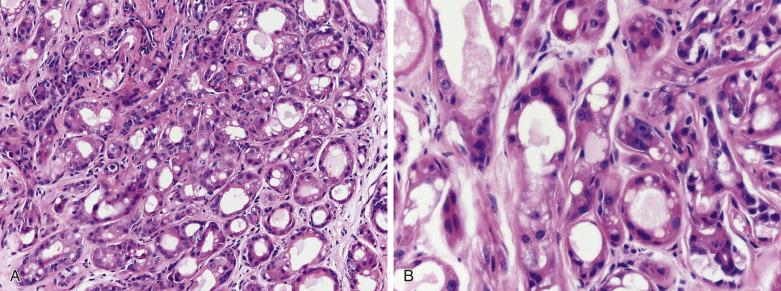
Although usually regular in nuclear and cytologic morphology, DNA tetraploidy has been identified in apocrine metaplasia. This is believed to be the explanation for forms of “apocrine atypia,” in which nuclear enlargement and variation in size with prominence of nucleoli can be observed (see Fig. 16.2 ). At present, the relevance and clinical significance of apocrine atypia is poorly understood. Some authorities believe this to be a purely benign phenomenon, whereas others have suggested it may be a precursor lesion of some forms of carcinoma such as apocrine carcinoma or medullary carcinoma. Although pure apocrine change is currently regarded as carrying a low but significant increased risk of subsequent development of breast cancer, most of the increased risk is related to the presence of coexisting atypical hyperplasia.
Apocrine metaplasia is generally easily recognized and distinguishable from other epithelial proliferative lesions. Apocrine metaplasia may be associated with cytologic and/or architectural atypia. Cytologic atypia is defined by the presence of a threefold variation in nuclear size and prominent nucleoli (see Fig. 16.2 ), features that are not often seen in standard papillary apocrine change. Apocrine atypia may occur alongside simple apocrine metaplasia in areas of sclerosing adenosis. This has been classified as atypical apocrine adenosis. The combination of large cells with atypical features in a pseudoinfiltrative process such as sclerosing adenosis may be mistaken for invasive adenocarcinoma. The presence of a myoepithelial component and the apocrine nature of the cells should be used to differentiate these conditions.
Most inflammatory disorders of the breast are straightforward to diagnose pathologically, but sclerosing lymphocytic lobulitis can be mistaken for malignancy both clinically and histologically.
Sclerosing lymphocytic lobulitis, also known as lymphocytic mastitis or lymphocytic mastopathy, is a well-recognized inflammatory disorder of the breast. Evidence supports an autoimmune etiology. A strong association exists with other autoimmune diseases, particularly with long-standing insulin-dependent diabetes mellitus and thyroiditis. The pattern of inflammation and expression of HLA class II antigens by breast epithelium is similar to that seen in autoimmune disorders such as Hashimoto thyroiditis.
Sclerosing lymphocytic lobulitis usually presents as a mass and can mimic carcinoma. The masses can be multiple or bilateral. By recognizing this condition clinically and on core biopsy, unnecessary surgery may be avoided. It can be seen in women from about 20 to 65 years old but is most common in women in their 30s. It has also been described in men.
Typically a poorly defined firm gray-white mass is seen, but sometimes the appearance is essentially that of normal fibrous breast tissue.
The characteristic feature is circumscribed clusters of lymphocytes in and around lobules and ducts and around blood vessels ( Fig. 16.3 ). Typically the lymphocytes are predominantly B cells. Germinal centers may be present. Lobular atrophy is frequently evident. Fibrosis and sclerosis are usually present between, and sometimes within, lobules. Epithelioid fibroblasts may be present but are not specific for this disorder. Patients with sclerosing lymphocytic lobulitis who have had a series of biopsies often show progression from dense inflammation to increasing lobular atrophy and fibrosis with decreasing inflammation. The changes seen later in the disease (lobular atrophy and fibrosis with little inflammation) are not specific to this disorder. The pathologic features in patients with and without diabetes mellitus are similar. Thus a general pathologic term such as sclerosing lymphocytic lobulitis or lymphocytic mastopathy is preferable to diabetic mastopathy.
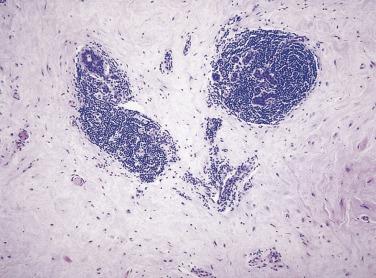
The diagnosis of sclerosing lymphocytic lobulitis is usually straightforward. It may be confused with lymphoma, but lymphoma typically has a different architecture, composed of sheets of cells, often with distinct morphology. An association between lymphoma and sclerosing lymphocytic lobulitis has been described in Japan but was not seen in European or American series. A pattern of inflammation like that of sclerosing lymphocytic lobulitis may be associated with carcinomas, particularly invasive lobular carcinoma, and, if marked, the inflammation may obscure the carcinoma.
Older studies found that the epithelial and stromal cells in most fibroadenomas are polyclonal ; however, more recently, MED12 mutations have been found to be common in the stroma of fibroadenomas, particularly those with an intracanalicular growth pattern. Similar mutations also occur in some phyllodes tumors, suggesting a biologic continuum.
Fibroadenoma is one of the most common causes of a benign lump in the breast. They may occur at any age after puberty but are most frequent in the third decade. They may be single or multiple and unilateral or bilateral. Clinically they present as firm or rubbery, mobile, well-defined masses that are painless. Most measure between 1 and 2 cm in diameter, but fibroadenomas measuring up to 4 cm are not uncommon. After the advent of screening programs for breast cancer, impalpable fibroadenomas have increasingly been detected by mammography.
The great majority of fibroadenomas behave in a benign fashion clinically and do not recur after adequate resection. Because they may be multiple it is not unusual for new lesions to become apparent, even close to the site of a previous biopsy. The trend is increasing for clinicians to adopt a more conservative approach to the management of women with suspected fibroadenoma using the triple approach of clinical examination, imaging, and fine-needle aspiration cytology or needle core biopsy. Provided that all the criteria for benignity are satisfied, surgery may safely be avoided in most patients. However, if the lesion is large (e.g., >3 cm) or is known to be increasing in size, excision is typically recommended.
Malignant change in fibroadenomas is uncommon. When seen it is usually in the form of carcinoma in situ; lobular carcinoma in situ (LCIS) being slightly more common than ductal carcinomas in situ (DCIS) while invasive carcinoma is rare. In a proportion of cases these lesions are also present in the adjacent tissues, and it may be difficult to establish whether involvement of the fibroadenoma is merely coincidental. Epidemiologic studies have shown a very slight increase in relative risk for subsequent invasive carcinoma of approximately twofold in patients with fibroadenoma. This risk is increased to threefold for fibroadenomas with a “complex” morphologic pattern (see later discussion) and to fourfold for patients with a family history of breast cancer. However, the absolute risk for uncomplicated fibroadenomas remains very low at 4%.
The gross appearances of a fibroadenoma are distinctive ( Fig. 16.4 ). They are sharply circumscribed, spherical or ovoid nodules, gray-white in color, and clearly separate from the adjacent breast tissue. The cut surface is usually slightly lobulated and often has a glistening myxoid appearance. Most lesions are firm to the touch, but in older women they may be hard and sclerotic, even calcified.
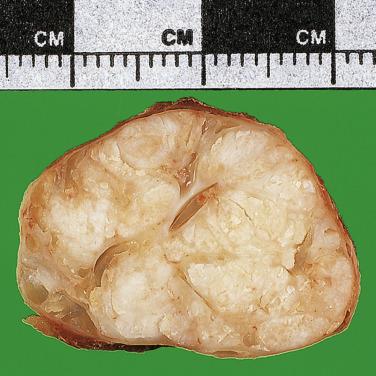
The dominant element is a proliferation of loose cellular stromal connective tissue, which surrounds a variable number of ductular structures ( Figs. 16.5 and 16.6 ). The stromal nuclei are spindle shaped and normally exhibit little pleomorphism with infrequent mitoses. The quality of the stromal matrix can vary markedly, some fibroadenomas having a definite myxoid background whereas others are hyalinized. The ductules also vary in configuration, and two classic patterns are described: intracanalicular when they are compressed by the stroma into clefts (see Fig. 16.5B ), and pericanalicular when the stroma appears to surround ductules in a circumferential fashion (see Fig. 16.6 ). Both patterns are often seen in the same lesion. The terms have no practical or prognostic significance and are purely descriptive. In about 20% of cases cystic changes, sclerosing adenosis, epithelial calcifications, or papillary apocrine change are seen, either alone or in combination; such lesions have been termed complex fibroadenoma by Dupont and colleagues. Epithelial hyperplasia is common, and, although tangential sectioning may produce worrying patterns, true atypical hyperplasia is rarely seen. In older patients, especially after the menopause, the stroma of fibroadenomas typically becomes less cellular and hyalinized. Calcification may also develop.

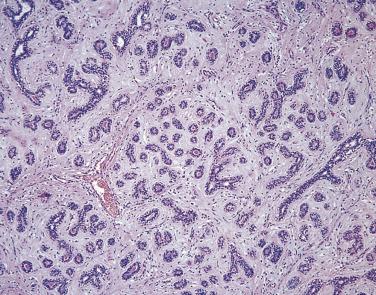
The most important lesion to consider in the differential diagnosis is benign phyllodes tumor (see later discussion). Although the latter is more often seen in an older age group, difficulties may be experienced with occasional fibroadenomas with a cellular stroma and prominent epithelial clefts. The distinction between fibroadenoma and benign phyllodes tumor may uncommonly be impossible to establish in excised lesions, but low stromal cellularity with relative uniformity of stromal nuclei and lack of mitoses would favor the former. It may be necessary to issue an equivocal report in rare circumstances. The WHO classification suggests that such lesions are better classified as fibroadenoma. In the past, complete excision of such cases was advised to reduce the risk of local recurrence, but current opinion is to manage as fibroadenoma. The distinction between fibroadenoma from mammary hamartoma is discussed later. Myofibroblastoma may show some features resembling fibroadenoma, but myofibromablastoma is devoid of breast parenchymal element, and the lesional cells are positive for desmin and estrogen receptor. Fibromatosis is a rare cause of a breast lump (albeit usually not well defined), but the fibroblastic proliferation around ductular structures may resemble a fibroadenoma. The infiltrative edge, cellularity of stroma, and relatively scanty epithelial component are all points in favor of a fibromatosis (see later discussion). The stroma of a fibroadenoma is typically strongly positive for CD34, whereas fibromatosis is CD34 negative and may be nuclear β-catenin positive.
Much confusion has been produced by inconsistent use of the terms juvenile and giant fibroadenoma. Indeed the latter has been used to describe both large fibroadenomas and, incorrectly, benign phyllodes tumor. In practice, most juvenile fibroadenomas are large and the term is best reserved for those fibroadenomas that occur in adolescents and have a rapid growth rate with increased stromal cellularity but lacking other features characteristics of phyllodes tumor. They are well-circumscribed, lobulated masses that may reach 15 to 20 cm in diameter, stretching the skin and distorting the nipple. Morphologically they have a very similar structure to that of the more typical fibroadenoma. The basic pericanalicular and intracanalicular growth patterns are seen, but the stroma is likely to be cellular rather than hyalinized ( Fig. 16.7 ). Nevertheless, the stroma remains in proportion to the epithelium without stromal overgrowth. Epithelial proliferation is usually present, may be florid, and care must be taken not to misinterpret foci of florid epithelial hyperplasia of usual type as atypical ductal hyperplasia (ADH). Juvenile fibroadenomas are benign and do not recur after complete local excision.
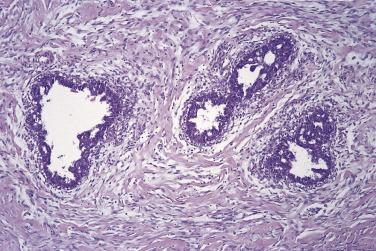
Although some authorities have accepted the entity of a pure mammary adenoma, most consider tubular adenoma to be an unusual type of fibroadenoma. It is true that some fibroadenomas contain focal areas with a tubular structure, but we exclude such cases by following the strict morphologic criteria laid down by Hertel and colleagues. They emphasized the well-circumscribed nature of the lesion composed of closely packed tubules with very little associated stroma.
The nature of the so-called pregnancy or lactating adenoma is also dubious. The great majority of lesions given this label are in fact simply nodules of physiologic lobular proliferation that become more prominent than the adjacent breast tissue and may appear clinically to be a distinct mass. Very rarely they may indeed be true tubular adenomas that undergo hyperplasia as a result of hormonal stimulation during pregnancy.
The clinical features of tubular adenoma are similar to those of fibroadenoma. A variety of benign noninflammatory mass lesions may present during pregnancy. In a consecutive series of 28 patients with an age range of 16 to 48 years (mean 23 years), three types of lesions were identified : Adenomas in the form of fibroadenoma (16 cases) and tubular adenoma (2 cases) were the most common lesions and usually showed lactational changes, with “lactational adenoma” (10 cases) being less frequent. The lesions presented either during pregnancy or in the postpartum period (up to a few months), usually as nontender masses.
Tubular adenomas are well-circumscribed nodules measuring between 1 and 4 cm in diameter, the majority being no greater than 2 cm. The cut surface is finely nodular.
The lesions are sharply demarcated from adjacent breast tissue but lack a true capsule. They consist of closely packed tubular structures of approximately the same size as the acini within a normal lobule ( Fig. 16.8 ). The tubules are lined by a single layer of luminal epithelial cells, but scanty flattened myoepithelial cells are also present. No nuclear atypia is seen, and mitoses are usually infrequent. A small amount of fine connective tissue stroma is seen between the tubules.
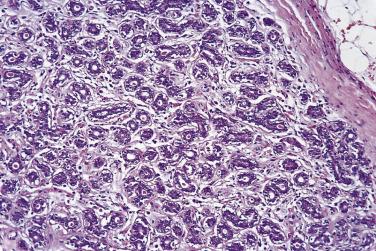
In lactational adenomas, dilated acini are present and show the typical alveolar pattern of lactating breast tissue. Luminal secretion is usually present.
The only lesions to be considered are fibroadenoma and tubular carcinoma. In the former the stroma is much more prominent, and the tubular structures present are arranged in well-defined islands. A clearly two-layered epithelium is seen in the tubules. Tubular adenoma should not be mistaken for tubular carcinoma. The latter has a characteristic stellate configuration with central fibrosis and elastosis with radiating tubules. The tubules are lined by a single layer of epithelial cells and infiltrate into stroma and adipose tissue at the periphery.
Mammary hamartomas are relatively uncommon lesions that occur predominantly in the perimenopausal age group. They may present as a large palpable mass, but surprisingly they are often impalpable and detectable only mammographically. Clinically they may be confused with fibroadenoma or phyllodes tumor. Radiologically they are large, well-circumscribed mass lesions with characteristic central lucency. Although they may cause marked distortion of the breast, hamartomas are benign and rarely recur after adequate local excision.
The lesions vary considerably in size from 1 to 20 cm, although the majority measure between 2 and 5 cm. They form well-circumscribed oval masses that have a cut section that may resemble normal breast tissue, a lipoma, or a fibroadenoma.
Microscopically hamartomas lack a true capsule, although they separate easily from adjacent breast tissue. They are composed of a variable mixture of connective tissue stroma and breast lobules ( Fig. 16.9 ). The latter usually have a normal, albeit architecturally somewhat disorganized, configuration. Occasional ectatic ducts are present, and these may become cystic. Epithelial hyperplasia is not a feature. Islands of adipose tissue are found frequently, often in the center of the lesion ( Fig. 16.10 ); the term adenolipoma may be applied to such lesions. Pseudoangiomatous hyperplasia or smooth muscle may be present in the stroma.
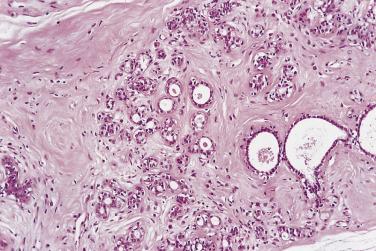
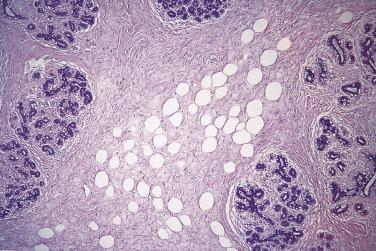
For palpable masses the differential diagnosis includes fibroadenoma for smaller lesions and juvenile fibroadenoma, pseudoangiomatous stromal hyperplasia (PASH) and phyllodes tumor for larger lesions. At the microscopic level, the presence of more extensive stroma with relatively few, if any, lobular structures distinguishes hamartomas from fibroadenoma and the cellular stroma surrounding characteristic leaflike epithelial clefts, the phyllodes tumor. Although PASH is described as a component of some hamartomas, it is usually a relatively minor component and should not be confused with mass-forming PASH in which the stromal component predominates. Definite diagnosis of a hamartoma, particularly the distinction from normal breast tissue, may be impossible in a core biopsy.
These uncommon tumors of the breast were first recognized by Müller, who used the term cystosarcoma phyllodes to describe a large breast tumor with a leaflike cut surface on macroscopic examination ( phyllos = leaf, Greek). Because most cases are benign, this nomenclature is misleading, as too is the designation giant fibroadenoma when some are undoubtedly malignant. For these reasons we agree with the WHO classification, which suggests use of the broad term phyllodes tumor qualified as “benign,” “borderline,” or “malignant” according to the histologic appearances. Although the term periductal stromal tumor was used in the past to describe phyllodes tumor, some authors prefer to maintain this term to describe rare biphasic breast tumors with stromal proliferation of variable cellularity and atypia around open tubules and ducts lacking a phyllodes architecture, to distinguish these from the typical phyllodes tumors. Phyllodes tumors have a clonal stromal component, and MED12 and TERT mutations are common. Mutations in well-known cancer genes such as TP53, RB1, ERBB4, and EGFR are present in some malignant and borderline tumors.
Phyllodes tumors are rare and account for less than 1% (0.2%–0.9%) of all mammary neoplasms and about 2% of fibroepithelial lesions in the breast. They occur predominantly in middle-aged or elderly women and are relatively rare below the age of 40 years. Phyllodes tumors form lobulated, firm masses that may grow rapidly and cause unilateral breast enlargement or even ulceration of overlying skin. Traditionally phyllodes tumors were said to be very large, but, perhaps because of greater breast awareness and mammographic screening, many patients now present with tumors of 2 cm diameter or less.
Phyllodes tumor forms a firm lobulated mass varying in size from 2 to 10 cm in diameter, with an average size of 5 cm. It is usually well circumscribed, often with a bosselated contour. The cut surface shows a characteristic whorled pattern, resembling a compressed leaf bud, with visible clefts. Larger tumors frequently exhibit cystic spaces, and foci of hemorrhage and necrosis are not unusual.
Microscopically, phyllodes tumors are composed of two major elements: clefts lined by epithelial cells and an associated cellular stroma ( Fig. 16.11 ). The epithelial element consists of the usual two layers of myoepithelial and luminal epithelial cells. Focal epithelial hyperplasia is not uncommon, and although this may occasionally be florid, carcinomatous change is extremely rare. Both lobular neoplasia and DCIS have been recorded; associated invasive carcinoma is an even greater rarity.
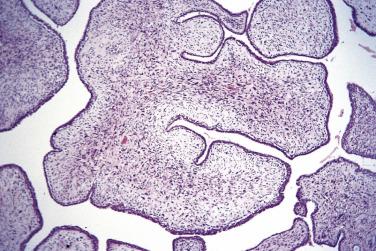
The appearances of the stromal element vary considerably from case to case. In the majority the features are those of a benign process. Although the stroma is more cellular than in a fibroadenoma, the spindle cells do not exhibit pleomorphism, and mitoses are infrequent. The presence of occasional bizarre giant cells ( Fig. 16.12A ) does not indicate malignant change (and may also be seen in fibroadenomas). At the other end of the spectrum a minority of tumors will show frankly sarcomatous change, characterized by stromal overgrowth and hypercellularity, marked nuclear atypia, and an increased mitotic count (see Fig. 16.12B ). In particular, specific patterns such as liposarcoma, rhabdomyosarcoma, chondrosarcoma, or osteosarcoma are clear indicators of malignancy. An intermediate group of tumors remains with appearances that pose problems for the pathologist and clinician in predicting the likelihood of local recurrence and metastatic malignant potential.

Although the majority of phyllodes tumors are benign (>60%), no objective system is globally recognized for grading phyllodes tumors. Numerous studies have used features of the stromal cells, including degree of cellularity, pleomorphism, mitotic count, and stromal overgrowth, as well as an infiltrative rather than a pushing margin to grade phyllodes tumors. Different studies have used different criteria and variable clinical management of patients (such as excision margin width), few have had more than 100 patients, and all are retrospective. Nevertheless, most studies find an association between grade and distant metastasis: Most distant metastases arise from malignant tumors. Distant metastasis is uncommon, occurring in fewer than 10% of malignant lesions (although published data vary); lung, pleura, and bone are the most frequent sites. Some studies find an association between higher grade and local recurrence, but the major determinant of local recurrence appears to be completeness of excision. No consensus exists on what is an adequate margin as this has not been studied sufficiently.
Differential diagnosis of phyllodes tumor has been considered previously in the section on fibroadenoma . In most cases the distinction from fibroadenoma is straightforward, but difficulties may sometimes be encountered. Hypercellular stroma is an important feature favoring a diagnosis of phyllodes tumor. A leaflike pattern is usually present in phyllodes tumor, particularly benign tumors, but can be seen in fibroadenoma. Another important consideration is that some phyllodes tumors show variable appearances of the stroma, including bland areas resembling fibroadenoma.
This heterogeneity may make diagnosis on a core biopsy difficult. Useful features favoring phyllodes tumor on core biopsy are increased stromal cellularity, stromal overgrowth and increased mitoses in the stroma, and tissue fragmentation. In cases showing overlapping features between fibroadenoma and benign phyllodes tumors, the WHO Working Group has proposed that the term benign fibroepithelial neoplasm be used, to avoid overtreatment. This term, however, should be limited to rare equivocal cases, as it does not represent a new diagnostic category.
Fibromatosis, primary sarcoma, and metaplastic carcinoma of the breast must be distinguished from malignant phyllodes tumors. Again, the mixtures of elements, with the leaflike epithelial clefts, are features of phyllodes tumor not seen in the other lesions. Expression of cytokeratins favors metaplastic carcinoma, but focal expression may be seen in phyllodes tumor. Most phyllodes tumors express CD34 in the stromal component, whereas spindle cell carcinoma is negative.
This broad heading covers those entities in which the combination of epithelial proliferation and stromal fibrosis and sclerosis forms a mass lesion that may be mistaken clinically, mammographically, and histologically for carcinoma. The specific lesions concerned are sclerosing adenosis, microglandular adenosis, radial scar (RS), and complex sclerosing lesion (CSL).
The term adenosis implies general disorders of glandular tissue, and is so nonspecific that its use should be abandoned. Sclerosing adenosis, however, denotes a more specific proliferative lesion arising from the terminal duct lobular unit (TDLU). It is found frequently as a microscopic component of fibrocystic change, but more rarely as a mass lesion that may be palpable. This latter form has been termed by some an adenosis tumor . Tumor is used here in its broadest sense, with no implication of neoplasia intended, although nodular sclerosing adenosis would perhaps be a preferable designation.
The majority of patients who present with a clinically palpable mass are premenopausal or perimenopausal, but the age range varies from 20 to 70 years. The mass is usually ill defined, but skin or deep fascial fixation does not occur. In contrast with carcinoma of the breast, associated pain and tenderness are not uncommon. After the advent of screening programs for breast cancer, sclerosing adenosis is detected with increasing frequency by mammography because of the presence of microcalcifications (see later discussion).
In the diffuse, microscopic form, no distinctive gross appearances are seen. The nodular or tumor type forms an ill-defined, firm or hard mass varying in size from 0.5 to 3 cm, with an average of 1.5 cm. No specific coloration is seen.
Histologically the normal configuration of a group of lobules is distorted by a disorderly proliferation of acini and intralobular stromal cells ( Fig. 16.13 ), which gives an overall whorled appearance. Compressed microtubular structures may be seen, but acinar lumina are frequently obliterated. A two-layered structure is usually visible, at least in part, but epithelial and myoepithelial cells may proliferate separately. Identification of the myoepithelial component is facilitated by the use of immunohistochemical markers such as anti–smooth muscle actin ( Fig. 16.14 ), smooth muscle myosin heavy chain, or p63. Epithelial nuclei are small and regular, usually without atypia, and mitoses are infrequent. Fine microcalcification is frequently found in the luminal spaces of the microtubular structures (see Fig. 16.13B ). In the diffuse form, several small, discrete lobular collections may be seen, often admixed with other features of fibrocystic change. In the nodular form the distorted lobules are fused together in an organoid configuration to form a mass lesion.

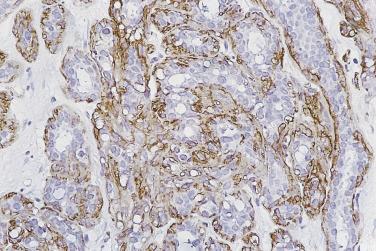
If the nodular form produces a large mass, it will become palpable and may be indistinguishable clinically from a carcinoma. Mammographically it is often impossible to distinguish the microcalcifications from those seen in low-grade cribriform DCIS. Histologically the main differential diagnoses are those of CSL and invasive carcinoma. Central elastosis with entrapped tubules, an important diagnostic feature of CSLs, is occasionally seen in sclerosing adenosis. Conversely, foci of sclerosing adenosis are found not infrequently associated with CSLs. This suggests that the two lesions may represent the ends of a spectrum of proliferative changes, and that attempting to separate them is a semantic argument. For the present it is probably sensible at a practical level to decide which pattern predominates and use that as the diagnostic category.
The distinction from invasive carcinoma, especially the tubular type, is the more important differential diagnosis. In a very small proportion of cases of sclerosing adenosis, extension into perineural spaces and blood vessels can be demonstrated. Areas of apocrine change may also be present, with cytologic atypia ; in the absence of confirmatory evidence neither feature should be taken as evidence of malignancy. The main distinguishing features from invasive tubular carcinoma are the lobulocentric configuration, the disorderly proliferation of microtubules lined by two-layered epithelium, and the lack of separate tubular structures with clear lumina, set in a desmoplastic stroma. Unlike sclerosing adenosis, tubular carcinoma may be associated with DCIS. In problematic cases, particularly in a core biopsy, myoepithelial markers unequivocally differentiate sclerosing adenosis from invasive tubular carcinoma.
Although the risk of subsequent invasive carcinoma appears to be low, both DCIS and lobular neoplasia can be present in association with sclerosing adenosis. The diagnosis of DCIS should pose little problem, because benign ductal epithelial hyperplasia is rarely seen in sclerosing adenosis. Lobular proliferations require a more cautious approach, and a diagnosis of LCIS should not be made unless all the criteria are fully satisfied.
Microglandular adenosis is a rare proliferation of small ductular or acinar structures, which may be mistaken for invasive carcinoma, particularly the pure tubular type.
Presentation of microglandular adenosis is usually in the form of a palpable mass with relatively sharp definition, which may be up to several centimeters in diameter. Smaller foci can be identified as a chance finding in breast tissue excised for other reasons. Age at presentation varies widely, from the mid-20s to over 80 years, with the majority of patients presenting between the ages of 45 and 60 years. Mammographic features are not specific but may be suggestive of malignancy.
In the past, most authorities regarded microglandular adenosis in its pure form as an entirely benign condition with no associated risk for the development of breast cancer. However, several authors have reported the coexistence of epithelial proliferative lesions, including atypical hyperplasia and in situ and invasive carcinoma. Recent molecular evidence suggests that some cases of microglandular adenosis are clonal, and identical genetic changes have been described in cases of microglandular adenosis with adjacent carcinoma. This suggests that some examples of microglandular adenosis may be nonobligate precursors of invasive carcinoma, which is often of triple-negative phenotype. Complete excision of microglandular adenosis, particularly when showing atypical features, is therefore now advised.
The cut surface of involved breast tissue shows an ill-defined area of nondescript fibrofatty tissue. The density and appearance vary, reflecting the nature of the underlying breast stroma.
Microglandular adenosis is defined as a proliferation of small, round acinar structures that are not lobulocentric but haphazardly arranged and appear to infiltrate fibrous stromal and adipose tissue. The glands are typically formed by a single layer of uniform, cuboidal epithelial cells, which have clear or eosinophilic cytoplasm and lack apical snouts ( Fig. 16.15 ). Mitoses are absent or very rare. A myoepithelial cell component is absent. No associated stromal reaction is seen, and occasionally hyalinization can occur. A periglandular distribution of reticulin fibers and glands may contain PAS-positive secretions. In very rare cases associated with epithelial proliferation the glands may vary in size. When microglandular adenosis shows cytologic atypia, small solid clusters, and/or fused irregular glands, the term atypical microglandular adenosis is used.
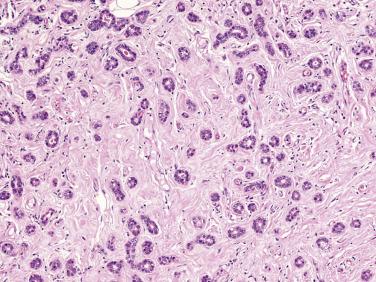
The principal differential diagnosis of microglandular adenosis is invasive adenocarcinoma of pure tubular type, particularly the sclerosing variant. In both conditions, abnormal infiltration of the glandular structures is seen in the mammary stroma and adipose tissue. A distinction can be made by using the following criteria: Tubular carcinomas usually have a distinctive stellate configuration with central elastosis and fibrosis. They excite a characteristic metachromatic stromal reaction that is not found in microglandular adenosis. The glandular structures in tubular carcinomas contain a high proportion of irregular shapes and elongated tubular forms, some showing branching. Cytologically, the cells in tubular carcinoma are larger with more abundant eosinophilic cytoplasm, often forming characteristic apical snouts. Secretion is rare in the luminal spaces of tubular carcinoma. Although most studies have emphasized that microglandular adenosis is characterized by a single layer of epithelial cells (see Fig. 16.15 ), some authors have reported the presence of myoepithelial cells in a minority of cases. In such cases the use of immunostaining with myoepithelial markers is of additional value in distinguishing microglandular adenosis from tubular carcinoma. Valuably, microglandular adenosis lesions express S100 protein ( Fig. 16.16 ) but lack estrogen receptor (ER) expression, whereas pure tubular carcinoma is typically ER positive and S100 negative. Sclerosing adenosis can be distinguished from microglandular adenosis by its lobulocentric configuration and the presence of a distinct layer of myoepithelial cells (see Fig. 16.14 ). The rare form of adenomyoepithelioma described by Kiaer and colleagues may have components indistinguishable from those of microglandular adenosis but typically has a dual myoepithelial and epithelial component. Its features are described in more detail in a later section.
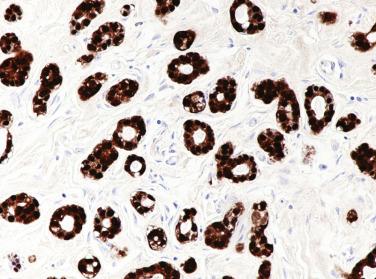
These distinctive stellate lesions, characterized by a fibroelastotic center, have previously had a varied and confusing terminology, including rosette-like lesion, sclerosing papillary proliferation, benign sclerosing ductal proliferation, and infiltrating epitheliosis . The latter is perhaps the least appropriate. RS has become the one most widely used. The lesions vary in size, and larger examples are more likely to have a more complex structure, including epithelial hyperplasia. For this reason Page and Anderson suggested that those that measure 1 to 9 mm be designated RS and those that are 10 mm or more should be termed CSLs.
RS/CSLs are reported to occur in women from 15 to 80 years in age but are most frequent in premenopausal and perimenopausal women. They were initially thought to be uncommon, perhaps because they do not usually present as a palpable mass. However, studies of surgical mastectomy specimens and breast tissue from autopsies have shown them to be common, multiple, and frequently bilateral. They are detected with increasing frequency in breast screening programs because it is virtually impossible to distinguish them from small invasive carcinomas mammographically. For this reason, all stellate lesions detected mammographically should be thoroughly sampled (e.g., with vacuum-assisted biopsy/excision) and examined histologically. It is important to search for epithelial atypia in a core biopsy with features of an RS. If atypia is present, the chance of associated carcinoma in the subsequent wider specimen is about 40%. If no atypia exists on the core then the risk of carcinoma in the adjacent breast is about 5%, so removal with a vacuum-assisted device is a reasonable alternative.
The gross appearances of small RSs are unremarkable; lesions that measure less than 3 to 4 mm may become apparent only on histologic examination. Larger RSs, together with CSLs, form firm, white stellate nodules with a dense center of variable size and fine radiating spicules of fibrous tissue. Central elastosis may be visible to the naked eye as pale yellow flecks.
The microscopic features depend on the stage of evolution of the lesion. Small early RSs are composed of a group of radiating ductules surrounded by cellular connective tissue, with minimal elastosis ( Fig. 16.17 ). In larger lesions an accumulation of dense sclerotic fibrous tissue occurs in the center of the lesion, and elastic tissue is more evident ( Fig. 16.18 ). The central tubules become compressed, but the normal two-layered epithelium is preserved ( Fig. 16.19 ). Tubular structures are also present within the radiating arms, and more peripheral cystic change is frequently observed (see Fig. 16.17 ). A variable degree of epithelial hyperplasia may be seen; this is most frequently of usual type ( Fig. 16.20 ), but careful evaluation for the presence of atypical features, both ductal and lobular, is important ( Fig. 16.21 ).
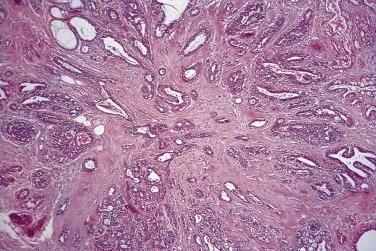
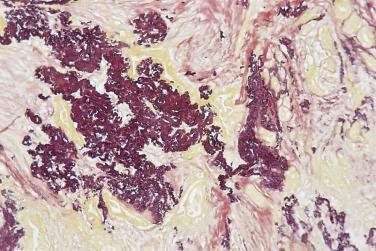
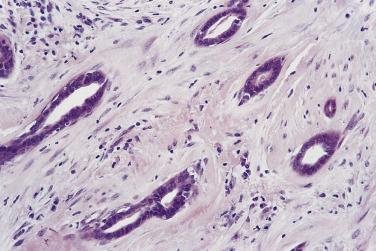
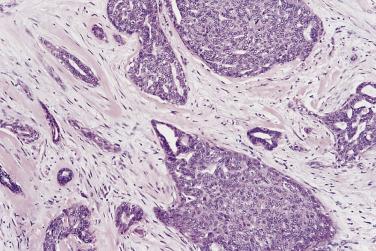
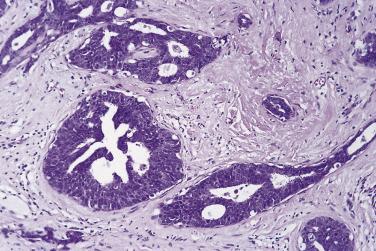
Apart from their larger size, CSLs, as the name implies, exhibit a wider variety of morphologic patterns. All the basic histologic features of an RS are present but, in addition, foci of sclerosing adenosis may be seen, with more florid epithelial hyperplasia and occasionally with papilloma formation. Thorough sampling of any lesion is required to obtain a full appreciation of the structures present.
Histologically RS/CSL must be distinguished from the nodular form of sclerosing adenosis and from tubular carcinoma. The former has been discussed previously, and this section will concentrate on the distinction from tubular carcinoma. The presence of entrapped tubules within the central fibroelastotic core poses the greatest problem. In RS/CSL the tubular structures are lined by two layers of epithelial cells in contrast to the single layer of the neoplastic tubules of a tubular carcinoma (compare Fig. 16.19 with Fig. 16.59 ). Immunohistochemistry (IHC) for myoepithelial markers is useful in confirming the difference in difficult cases. The entrapped tubules of RS/CSL are flattened and elongated, whereas those of a tubular carcinoma are more rounded or oval with open luminal spaces. The nature of the associated connective tissue stroma also provides a useful contrast; this is typically dense and relatively acellular in RS/CSL, but desmoplastic in tubular carcinoma.
As noted earlier, a variable degree of epithelial proliferation often exists in RS/CSLs, ranging from usual hyperplasia to atypical hyperplasia of either (or both) ductal and lobular types. The latter needs to be distinguished from in situ carcinoma, but it is quite clear that both in situ ( Fig. 16.22 ) and invasive carcinoma may arise in association with RS/CSLs. As long as the diagnostic criteria for malignancy are met, the appropriate designation should be recorded.
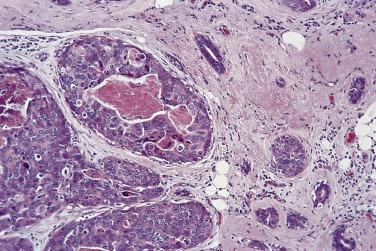
Papillomas are thought to be hyperplastic lesions of ducts. They occur predominantly in women between the ages of 35 and 55 years. Most patients present with single-duct nipple discharge, often bloodstained, whereas in a minority a palpable mass may exist, usually close to the areola. Duct papillomas can be divided into two main subgroups: central, which arise from the main ducts and are usually single, and peripheral, which are associated with TDLUs and are often multiple.
All the available evidence suggests that the finding of a solitary central benign duct papilloma carries no increased risk of subsequent carcinoma, whereas multiple papillomas have an association with both concurrent DCIS and an increased risk of subsequent carcinoma.
In the great majority of cases, duct papillomas measure less than 2 to 3 mm in diameter and are therefore difficult to visualize with the naked eye. The site of a papilloma within a dilated duct may be indicated by adjacent amorphous debris, including blood clot, but, in most cases, the pathologist receives a specimen of fibrofatty tissue in which no gross abnormality is discernible. Multiple blocks may be required to identify the site of the lesion. Larger papillomas up to 1 to 2 cm may become encysted.
Microscopically, papillomas consist of a fronded fibrovascular core attached by a stalk to the duct wall ( Fig. 16.23 ). Multiple fronds from the same lesion may extend into several adjacent duct spaces. Occasionally the base may be sessile. The fronds are covered by two types of epithelium ( Fig. 16.24 ), an outer cuboidal or columnar luminal cell layer and an inner myoepithelial cell layer. Any doubts concerning the presence of two cell types may be resolved by use of IHC for myoepithelial markers. The myoepithelial cell layer may be incomplete, but in rare cases it forms a major part of the epithelial proliferation. In the case of single, central duct papillomas the adjacent duct structures are usually unremarkable, although they may be dilated and contain hemorrhagic debris. Apocrine change is common and is usually focal. Infarction and hemorrhage are less common.
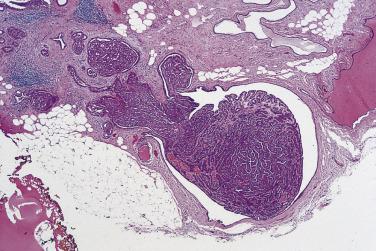
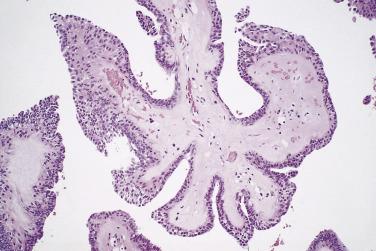
Multiple papillomas are usually found in smaller peripheral ducts, frequently as part of a focal or more diffuse epithelial proliferative process. They may therefore be accompanied by almost any type of epithelial lesion, including usual type hyperplasia, ADH, lobular neoplasia, or DCIS. It is important to search for epithelial atypia in a core biopsy sample with features of a papilloma. If atypia is present the chance of associated carcinoma in the surgical specimen is about 40%. If no atypia is seen on the core then the risk of carcinoma in the adjacent breast tissue is approximately 5%.
Papillary lesions can be categorized into three main groups; morphology and IHC for myoepithelial markers (smooth muscle actin, p63, and smooth muscle myosin heavy chain), basal keratins (cytokeratin [CK] 5 and CK14), and ER are useful in separating them. Intraductal papillomas have a myoepithelial layer between the fibrovascular cores and the overlying epithelium, as well as around the duct space. In addition, any associated epithelial hyperplasia of usual type shows patchy expression of basal keratins and typically ER. Papillary carcinoma in situ shows an absent myoepithelial layer at the epithelial-stroma interface of the fibrovascular cores, and the epithelium is usually negative for basal keratins. The epithelial cells usually show strong diffuse ER expression. The third and least common category of benign papilloma with involvement by DCIS or ADH shows a retained myoepithelial layer and absent expression of basal keratins in the atypical areas.
Sclerosed papillomas may contain entrapped epithelial structures. Care must be taken to interpret these correctly to avoid overdiagnosis of malignancy (see later section on encysted papillary carcinoma). Retention of a myoepithelial layer with use of IHC may be helpful. Smooth muscle myosin heavy chain and p63 are the markers of choice as they are expressed by myoepithelium, but not by myofibroblasts/fibroblasts; smooth muscle actin is expressed by both.
If a papillary lesion is completely infarcted, then definite categorization is usually not possible.
This term does not delineate a specific entity but has been used in the past to describe any mass lesion of the nipple that is benign. However, the main entity is composed of an exuberant proliferation of epithelial structures that exhibit both papillary and adenomatous patterns. Because of the variability of the histologic appearances, disagreement has existed concerning the optimal nomenclature, some preferring the term florid papillomatosis of the nipple (or subareolar duct papillomatosis ) whereas others use nipple adenoma or papillary adenoma .
Adenomas of the nipple may occur at almost any age, with a peak in the perimenopausal era. They present clinically as nipple discharge, which is often bloody, or as a firm nodule beneath the nipple epithelium. The latter may be reddened and even crusted, mimicking the appearances of Paget disease.
The pathologist usually receives all or part of the nipple and areola, depending on the size of the lesion, which rarely measures more than 1 to 1.5 cm. The nodule is ill defined and firm but has no specific distinguishing features.
The microscopic features are variable but consist in essence of a diffuse papillary ductular epithelial proliferation, often intermingled with adenomatous areas ( Fig. 16.25 ). The epithelium is two layered ( Fig. 16.26 ) with a variable degree of epithelial hyperplasia, typically of usual type. Normal ductular and lobular structures may be included within the lesion. A cellular stroma may accompany the proliferative process. At the periphery, a pseudoinfiltrative pattern of entrapped tubules may be seen and this, together with a tendency toward nuclear hyperchromasia, may lead the unwary into a mistaken diagnosis of malignancy. Because of its heterogeneous growth pattern, some authors have classified adenoma of the nipple into four categories or patterns according to the dominant structural feature: adenosis pattern, papillomatosis pattern, sclerosing papillomatosis pattern, and mixed proliferative pattern.
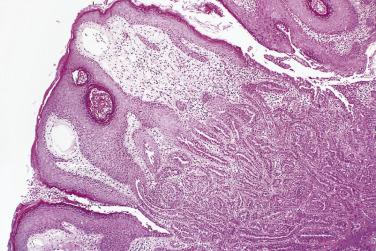
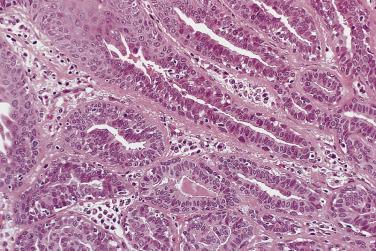
Adenoma of the nipple must be distinguished from the rare entity of syringomatous adenoma of nipple. In this lesion an infiltrate of tubular structures is present among lactiferous ducts, in contrast to the intraductal papillary proliferation of nipple adenoma ( Fig. 16.27 ). As indicated earlier, the pseudoinfiltrative pattern in nipple adenoma may raise the possibility of a malignant process. The regularity of the epithelial structures throughout the lesion and absence of the characteristic features of DCIS favor a benign process, as does the presence of a two-layered epithelium. Careful sampling is important as, although the risk is low, there can be associated carcinoma.
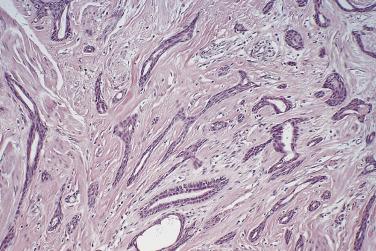
This term was introduced by Azzopardi and Salm to describe a solid benign lesion, usually occurring in association with one of the main breast ducts with a sclerosing adenomatous or papillary structure. As more cases have been described it has become clear that considerable overlap exists in the morphologic appearances with sclerosing duct papilloma, sclerosing adenosis, and CSL, but the central location in the breast is a distinguishing feature in most cases. The majority are thought to evolve by sclerosis of duct papillomas.
Ductal adenoma is uncommon and can occur at any age after puberty, but the majority have been found in women over the age of 45 years. Most present as a solitary palpable mass close to the nipple, although some lesions may be peripheral.
Grossly most ductal adenomas appear as well defined, pale brown or gray nodules measuring up to 3 cm in diameter. In some cases a clear association with a duct lumen or a cystic structure can be identified.
The microscopic appearances are varied, depending in large measure on the amount of associated fibrosis. Single or multiple adenomatous nodules are seen, composed of two-layered epithelium, luminal secretory cells, and basal myoepithelium ( Fig. 16.28 ). This can be confirmed by immunostaining for myoepithelial markers. In some cases the epithelial proliferation has a papillary configuration. The lesion is surrounded by dense fibrosis, which often contains fragmented elastic tissue, presumably derived from the original duct, parts of which may be discernible. A minority of duct adenomas have a central stellate sclerosing appearance. Apocrine change is frequently seen within the epithelial component, and this may exhibit nuclear atypia.
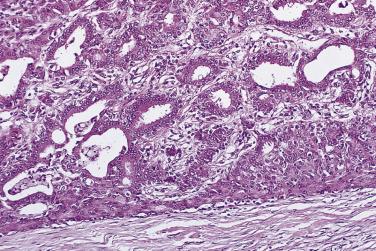
Ductal adenomas are benign lesions, and care must be taken not to overdiagnose malignancy. This is particularly the case if entrapped tubules are found and where apparent epithelial atypia exists. As noted earlier, considerable overlap exists between its histologic features and those of both sclerosing adenosis and CSL, and in some cases it may be impossible to make a firm distinction.
This spectrum of lesions has previously been known under a variety of names, including blunt duct adenosis, columnar alteration with prominent apical snouts and secretions (CAPPS), atypical cystic lobules, cancerization of small ectatic ducts of the breast by ductal carcinoma in situ (DCIS) cells with apocrine snouts, enlarged lobular units with columnar alteration, hypersecretory hyperplasia, mammary ductal intraepithelial neoplasia-flat type, clinging DCIS of monomorphic type, and hyperplastic unfolded lobules. The descriptive term columnar cell lesion is preferred for this group of processes.
The apparent increase in incidence in columnar cell lesions is due both to the improved recognition of the entity by histopathologists and to the greater number of needle core biopsy specimens received from mammographically detected microcalcifications. Indeed, one of the earliest descriptions of columnar cell lesions identified that microcalcification was present in almost three-quarters of cases of CAPSS.
The true significance of these lesions remains somewhat unclear. This is in part due to the variety of appearances that may be seen within this range of lesions, as well as the difficulty in evaluating the literature due to the range of terminology previously used. Even after the term columnar cell lesions became widely applied by reporting pathologists for the group as a whole, there were alterations to the nomenclature for cases showing atypical features; thus, Stuart Schnitt identified atypical variants of columnar cell lesions as either columnar cell change with atypia or columnar cell hyperplasia with atypia, while the WHO classification recommends the term flat epithelial atypia for the group of atypical columnar cell lesions, specifically those without superimposed architectural atypia.
Columnar cell change without atypia is a benign change with no further clinical implications, whether present in a needle core biopsy or a surgical excision specimen. It is the presence of cytologic atypia in the form of flat epithelial atypia (FEA) or architectural atypia (which can be regarded as ADH [discussion to come]), particularly when in a core biopsy sample, that causes uncertainty and concern. The proportion of cases that will have associated DCIS or invasive carcinoma adjacent to the index lesion has been reported to be as high as 30%, although more recent series and meta-analyses have suggested lower figures than this, particularly if FEA is the only lesion present. In a recent meta-analysis, the overall pooled estimate of 32 studies was 11.1% for pure FEA (range 0%–42%) and, when the investigation was restricted to 16 higher-quality studies, the cancer upgrade pooled estimate was found to be 7.5% (95% CI, 5.4–10.4). Of note, it is also evident that FEA often coexists with other atypical lesions, such as lobular in situ neoplasia and atypical ductal hyperplasia, than anticipated by chance ; if these processes are present the risk of there being associated DCIS or invasive carcinoma in the adjacent tissue is higher.
Given these upgrade rates (regardless if there is associated architectural atypia) it is prudent, if the diagnosis has been made on narrow gauge core biopsy specimens (e.g., 14 or 16 gauge) or on limited vacuum-assisted core biopsy, to examine further tissue. This may be in the form of a diagnostic surgical procedure or a more thorough vacuum-assisted sampling (akin to vacuum-assisted excision).
The association of flat epithelial atypia with DCIS and invasive carcinoma, the latter often of tubular type, along with genetic similarities between such coexisting processes suggests that, at least in some cases, flat epithelial atypia may behave as a precursor lesion. However, following excision (and thus confirmation that there is no adjacent malignant lesion present at the time of diagnosis), the risk of subsequent development of DCIS or invasive carcinoma appears to be very low, suggesting that this risk is actually very small.
There are no specific gross appearances associated with the columnar cell lesions, which are often present in conjunction with fibrocystic change. As these lesions as usually detected through mammographic breast screening programs, there is typically radiologic evidence of calcification in the specimen. Histologically this calcification is seen in secretions in the lumen of the lobular units bearing the columnar cell process.
Columnar cell change arises in the TDLUs, and the low-power view demonstrates the lobulocentric nature of the process ( Fig. 16.29 ). Of note, cells with columnar cytomorphology line larger ducts and do not represent a columnar cell lesion. At higher power the columnar cell morphology of the epithelial cells can be identified lining the TDLU, and the structures are often mildly dilated and bear secretions that, as noted, may be calcified. The columnar cells are one or two cells in depth, are arranged perpendicular to the basement membrane, and are cytologically bland ( Fig. 16.30 ). Apical snouts are often present and can be noted as “blebs” on the luminal surface of the cells. The nuclei are uniform, bland, and oval or elongated in shape. Mitotic figures are very rare.
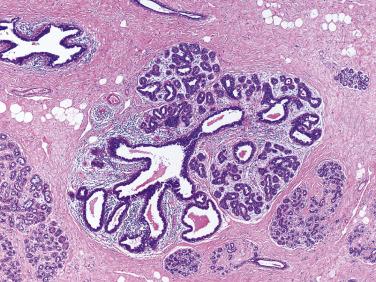
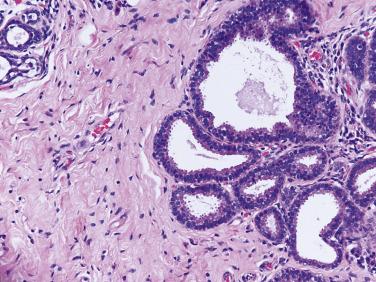
Columnar cell hyperplasia is formed from cells with the same appearance as in columnar cell change, but the epithelial lining is more than two cells thick, sometimes with some crowding being seen. The architecture may include tufts or hummocks ( Fig. 16.31 ) but not bridges, punched-out luminal spaces, or micropapillary structures. There may be overlapping of nuclei, but the cytonuclear features are essentially the same as the nonhyperplastic form. Apical snouts may be more obvious with a somewhat hobnail appearance and intraluminal secretions, with microcalcification sometimes of psammomatous morphology. If true micropapillae, bridges, or a cribriform architecture is seen, then a diagnosis of ADH or DCIS is appropriate (depending on the extent of the lesion [see upcoming discussion]) rather than columnar cell hyperplasia.
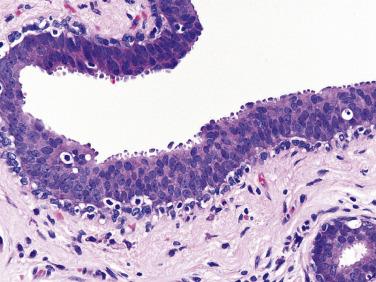
Columnar cell change and columnar cell hyperplasia may, rarely, show more overt, classic cytologic atypia. Such lesions are also known as flat epithelial atypia. This may be identified in either columnar cell change or in columnar cell hyperplasia.
In flat epithelial atypia, the TDLUs are, on low power, often darker than typically seen in columnar cell change. The lobules are often mildly to moderately dilated, as in the less cytologically worrisome processes. However, the internal luminal shape of the acini in flat epithelial atypia is typically smooth and rounded, rather than irregular in outline as often seen in nonatypical forms (columnar cell change and columnar cell hyperplasia). The cells lining the TDLUs are formed from one or more layers of small, monotonous cuboidal cells akin to those seen in ADH/low-grade DCIS ( Fig. 16.32 ). The nuclei are regular, round, sometimes with one or more nucleoli and clumped chromatin. Mitotic figures are very uncommon. Much less commonly, a more columnar shape is maintained, and the cells remain perpendicularly arranged to the basement membrane but with oval nuclei with more classic cytologic atypia, such as more overt pleomorphism and an increase in nuclear size with occasional mitoses ( Fig. 16.33 ), but not amounting to high grade; this intermediate grade process is also classified as flat epithelial atypia.
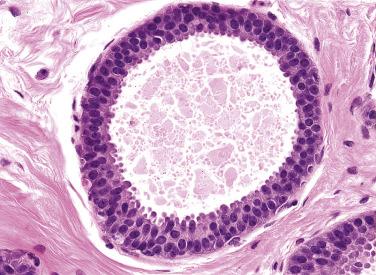
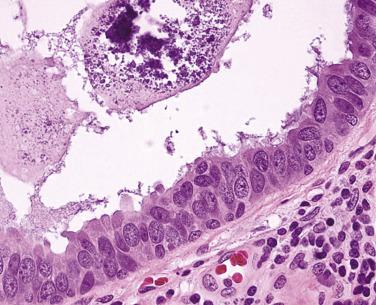
If marked pleomorphism is present or there are features of high-grade atypia, then the lesion should not be classified as flat epithelial atypia but as flat high-grade DCIS (just as there is no entity of high-grade ADH). Similarly, if there is true architectural atypia in the form of more solid bridges or well-defined, true micropapillary structures, then the diagnosis of ADH/low-grade DCIS should be considered and not flat epithelial atypia ( Fig. 16.34 ).
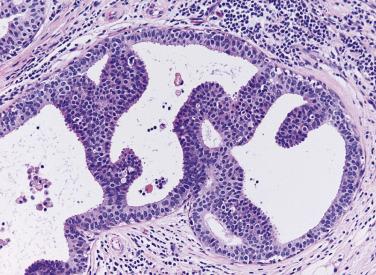
Columnar cell lesions arise within TDLUs, and recognition of the topography of the process and the columnar cell morphology of the cells enables the correct diagnosis to be made in the majority of cases. Apocrine change may mimic columnar cell change and also arises in the TDLU. In problematic cases estrogen receptor assessment can be helpful; columnar cell lesions express luminal cytokeratins (CK18 and CK19), estrogen receptor, and progesterone receptor, while apocrine cells are typically estrogen receptor negative and express androgen receptor.
Evidence of an association between epithelial hyperplasia and carcinoma was demonstrated by Page and Dupont from review of a very large series of women who had undergone biopsy for benign breast disease. The risks attributable to these lesions can be summarized as follows:
Approximately 70% of women undergoing breast biopsy for benign disease have no significant histologically evident epithelial hyperplasia. This group of women have no increased risk for development of carcinoma over a 15-year period compared with the general population.
Of benign biopsies, 25% bear epithelial hyperplasia of usual type, and approximately 4% of these women develop breast cancer within 15 years, which is a twofold increase in risk.
The group of women who have atypical hyperplasia is small (~2% of biopsies); 10% develop breast cancer during 15-year follow-up, representing a fourfold to fivefold increased risk. The subsequent tumors in women diagnosed with atypical hyperplasia in these studies have occurred with roughly equal frequency in either breast.
Proliferative breast disease usually coexists with other benign conditions such as fibrocystic change, papilloma, or a sclerosing lesion. In general it does not have distinctive clinical features.
Epithelial hyperplasia is generally a microscopic abnormality that is invisible to the naked eye. It commonly occurs in association with fibrocystic change or other benign conditions, and the overall appearance of the involved breast may show the features of these benign conditions, as noted earlier.
The histologic appearances and differential diagnoses of usual epithelial hyperplasia (usual ductal hyperplasia, proliferative disease without atypia) and atypical ductal hyperplasia (proliferative disease with atypia) are described next.
Any increase in the number of epithelial cells and in number of epithelial layers above the myoepithelial cell is regarded as epithelial hyperplasia, but this is recognized as significant if the epithelium is four cells or more in depth (i.e., of moderate degree). The detailed histologic features are described later in differential diagnosis. Further classification is based on the degree and nature of the hyperplastic process.
The term mild usual epithelial hyperplasia (which has no significant attributable increased risk of breast cancer) is used to note an increase of no more than a four-cell depth extending up from the basement membrane. Moderate hyperplasia describes an increase of more than four cells thick in which there may be bridging of the luminal space ( Fig. 16.35 ). In florid hyperplasia the space is distended and may even be obliterated ( Fig. 16.36 ). The distinction between moderate and florid epithelial hyperplasia of usual type is relatively subjective; clearly this is a continuous spectrum of changes. However, pragmatically, there is little necessity to sharpen the distinction between the categories of moderate and florid usual epithelial hyperplasia as they are grouped together to form a single category for the purpose of risk assessment.
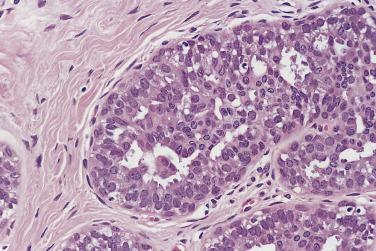
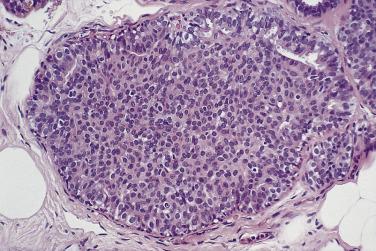
Epithelial hyperplasia can occur in the terminal ducts, peripheral small ducts, or the large ducts and may involve areas of columnar cell change, papillomas, or other benign conditions. The site and association with other processes have no known additional significance with regard to the risk of subsequent carcinoma.
Ductal hyperplasia of usual type can be distinguished from ADH and DCIS by its architectural low-power and microscopic high-power cytologic features. The population of cells is mixed rather than monomorphic and uniform. Luminal epithelial cells predominate in most cases, but forms expressing basal cytokeratins (e.g., CK 5/6 and CK14) are also present, and occasional lymphocytes may also be seen ( Fig. 16.37 ). The epithelial cell nuclei are in general ovoid and small but show variation is size and morphology (see Fig. 16.37 ); this, in itself, is helpful in distinguishing the process from a clonal proliferation such as ADH or low-grade DCIS. Similarly, as a hyperplastic process, the cells have a haphazard and irregular arrangement (see Fig. 16.36 ) and can be seen in swirling sheets, with irregular bridges that are often somewhat ragged in outline. A streaming character may be seen in sheets or when cells are arranged parallel to the line of papillary or bridge formations. The luminal spaces formed, or remaining peripherally, are irregular, not sharply defined and often slitlike (see Figs. 16.35 and 16.36 ). A particularly helpful diagnostic feature is the preservation of a peripheral (or partial) ring of narrow slitlike luminal spaces. It is especially helpful to examine the overall arrangement of cells within usual epithelial hyperplasia; this is typically uneven and varying in density from duct space to duct space and, indeed, within each duct space. Intraluminal necrosis and hemorrhage and surrounding stromal changes may occur but are rare and usually only confined to the most florid examples, particularly when the epithelial hyperplasia is seen within another underlying process such as a papilloma. Microcalcification can uncommonly occur in usual epithelial hyperplasia and does not help in distinguishing between this condition and atypical hyperplasia or DCIS.
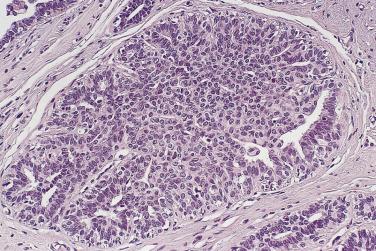
One form, gynecomastoid type of usual epithelial hyperplasia, may cause diagnostic difficulties. This has a rudimentary micropapillary growth pattern and may mimic low-grade micropapillary DCIS, but as the name suggests, it resembles the changes seen in the male breast in gynecomastia. Small rudimentary micropapillary clusters of epithelial cells protrude into the lumen of the duct space, but they are not well-formed structures with thin stalk and more bulbous tip composed of evenly spaced, uniform, and regular epithelial cells, as in low-grade DCIS. The nuclei in gynecomastoid type hyperplasia are typically somewhat pyknotic and are often distributed around the periphery of the small micropapillary structures.
Features and techniques that may be of assistance in distinguishing usual epithelial hyperplasia from ADH and DCIS are described next.
Page's broad criteria for ADH were modeled on low-grade DCIS of cribriform and micropapillary subtypes. Lesions with some, but not all, of the features of low-grade DCIS are classified as ADH. Microscopic low-power (architectural) and high-power (cytologic) features are both required to make the diagnosis ( Figs. 16.38 through 16.40 ).
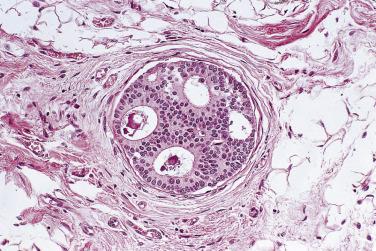
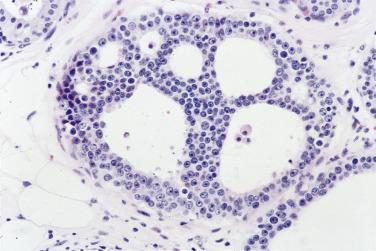
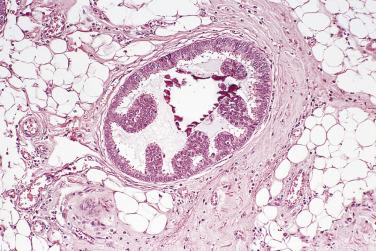
The criteria Page used to identify DCIS, and on which ADH was modeled, include:
A uniform population of cells
Smooth geometric spaces between cells or micropapillary formations with even cellular placement
Hyperchromatic nuclei
Separation from DCIS requires strict adherence to criteria. Page and colleagues described how the full features of DCIS should be present in at least two duct spaces for diagnosis of low-grade DCIS. Any lesion falling short of this is classified as ADH. This definition provides some objectivity to distinguish these two clinically significant entities. Other groups have used a measure of size; Tavassoli and colleagues require definite features of DCIS extending over an area at least 2 mm in maximum dimension for diagnosis of DCIS, while smaller lesions are classified as ADH. In practical terms, these two descriptions represent essentially similar lesions.
We would advise caution when making the diagnosis of ADH; this is an uncommon entity and specifically should not be used for cases of usual epithelial hyperplasia showing occasional cytologic atypia. Additional useful rules of thumb are as follows:
These lesions (ADH) are small and microfocal (at least <5 mm) and are localized.
ADH should not be diagnosed unless the diagnosis of low-grade DCIS has been seriously considered, but the features are not sufficiently extensive for this diagnosis.
It must be remembered that ADH is not a cytologically high-grade lesion. The diagnostic term should be confined to the specific entity described earlier with known long-term risk—not simply focal cytologic atypia within another epithelial proliferative lesion. Very minor changes amounting to mild atypical hyperplasia appear to be irrelevant with regard to risk and are best disregarded when seen in a background of florid or moderate usual epithelial hyperplasia.
ADH falls in the borderland or grey area of epithelial proliferative lesions of the breast. Some studies using standardized criteria have described a satisfactory interobserver concordance among groups of expert pathologists, but reproducibility in separating atypical hyperplasia from low-grade DCIS in other studies appears poor.
Another useful rule for separating ADH from usual epithelial hyperplasia is to recognize that ADH is a clonal, uniform population of cells (see Fig. 16.39 ) in contrast to usual epithelial hyperplasia where the cells are polyclonal and vary in size and shape. Aside from the regularity in cytologic shape in ADH, the architecture is also structured rather than the haphazard arrangement seen in usual epithelial hyperplasia, with evenly spaced cells forming distinctive cribriform spaces or micropapillary structures (see Fig. 16.40 ).
The clonality of ADH (and low-grade DCIS) can be demonstrated by the uniform, homogeneous lack of expression of basal cytokeratin markers such as CK5, CK5/6, and CK14 in the epithelial cells of the atypical proliferation with uniform positivity with luminal cytokeratin markers such as CK19. Conversely, in usual epithelial hyperplasia a mixed, heterogeneous expression of luminal and basal markers is seen, confirming the lack of clonality of the proliferation. Similarly, estrogen receptor can sometimes be helpful diagnostically in difficult intraductal epithelial proliferations; ADH and low-grade DCIS are invariably uniformly strongly ER positive ( Fig. 16.41 ), while in usual epithelial hyperplasia the staining pattern is often variable in extent but particularly is typically heterogeneous in intensity. In only occasional lesions of usual epithelial hyperplasia are there contiguous groups of positive cells. It should be noted that immunohistochemical examination of intraductal epithelial proliferations with basal and luminal markers is not necessarily of assistance in distinguishing hyperplasia from higher grade clonal proliferations, which may express basal markers focally rather than uniformly, although low-grade lesions express luminal cytokeratins only.
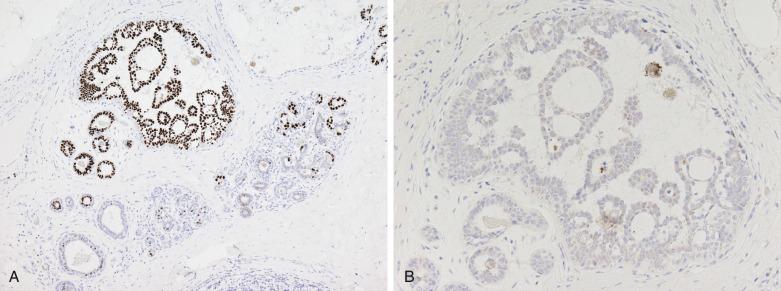
The presence of mitoses, necrosis, or hemorrhage is not a useful discriminatory feature in distinguishing ADH from usual epithelial hyperplasia, or indeed from low-grade DCIS; these features are uncommonly seen in any of these proliferations.
The distinction of ADH from low-grade DCIS may be difficult. The diagnosis of ADH is based on its similarity to low-grade DCIS on hematoxylin and eosin (H&E) stains, and both lesions are uniformly and strongly ER positive, express luminal cytokeratins, and are HER2, p53, and basal cytokeratin negative. The cytogenetic features of low-grade DCIS and ADH are also essentially similar. In essence, distinguishing the two processes is based on assessment of the extent of the process, both within the individual duct and the number of ducts that bear the proliferation in a pure form.
It can certainly be difficult to reach a definitive diagnosis when a more extensive uniform, monomorphic clonal epithelial proliferation partly involves numerous spaces with occasional micropapillae and bridges, but there is not complete involvement of any two spaces. In this setting (particularly if the process is more extensive [e.g., >10 mm]), a diagnosis of low-grade DCIS should be considered rather than classifying this as ADH.
In essence, we emphasize the need to apply Page's and/or others’ criteria very strictly and reiterate that ADH is a microfocal lesion formed from clonal, low-grade, luminal epithelial cells and should not be reported when there is focal cytologic atypia in a process which otherwise, on architectural and cytologic grounds, amounts to usual epithelial hyperplasia.
The cytologic, biologic, and genomic features of ADH and low-grade DCIS are essentially the same. If more established forms of the process are seen centrally in a surgical specimen but immediately adjacent ducts are only partially involved, this does not represent the microfocal lesion described earlier. In this setting we would not diagnose ADH but would interpret the entire lesion as one process and as low-grade DCIS, even if the peripheral spaces are not completely cytologically and architecturally abnormal.
Finally, if a monomorphic evenly spaced, low-grade epithelial proliferation involving less than two complete spaces (i.e., equivalent to ADH) is identified in a needle core biopsy, the adjacent breast tissue that has not been sampled may harbor in situ (or less commonly invasive) carcinoma. It is impossible to assess whether this represents part of a larger lesion because of the nature of the sampling undertaken. In this setting, we would argue that the term atypical intraductal epithelial proliferation (AIDEP) is more appropriate than classifying the process as ADH, to maintain the specific implications of subsequent cancer risk associated with the diagnosis of ADH. Indeed, approximately 40% to 50% of such diagnoses will reveal DCIS or invasive carcinoma in the subsequent diagnostic surgical specimen following core biopsy if smaller width core biopsy samples (e.g., 14 or 16 gauge) are examined initially. Such “upgrade” is less common with more extensive sampling, particularly with larger vacuum-assisted biopsy specimens (~10%–20% in most series), as those cases with low-grade DCIS can more often be identified preoperatively in the larger amounts of tissue received. However, in most studies, no group has been identified that does not have a significant risk of upgrade, and evaluation of further tissue, ideally by vacuum-assisted excision, or alternatively by diagnostic surgical excision is recommended.
A further, diagnostically difficult group of atypical hyperplastic lesions is recognized with apocrine morphology. These are discussed under the differential diagnosis of apocrine DCIS later. However, we currently restrict the use of the specific term ADH to nonapocrine lesions, as it is these that have been demonstrated to carry the increased risk of development of breast carcinoma in long-term follow-up series, requiring the presence of both architectural and cytologic characteristics of low-grade ductal carcinoma in situ.
This epithelial process, which occurs in the TDLU, represents a spectrum from mild atypical lobular hyperplasia (ALH) through to florid lobular carcinoma in situ. This range is, by some, regarded as a single entity lobular neoplasia because the cell type in both forms of the process is morphologically identical ( Figs. 16.42 through 16.45 ) and the distinction is based on the extent and degree of TDLU involvement. Similarly, the genetic changes throughout this spectrum of lobular neoplasia are the same; greater genetic and immunohistologic abnormalities have not been identified in LCIS compared to ALH. In essence, ALH and LCIS are distinguished based on the extent and degree of involvement of a lobular unit by the lesion.
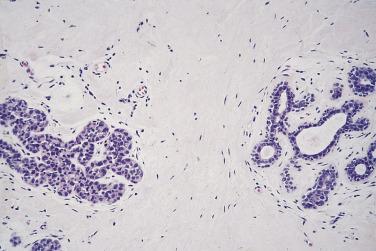
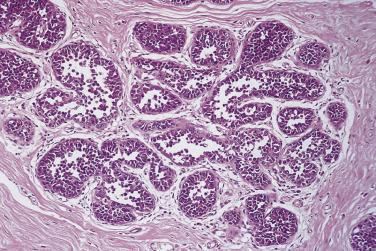
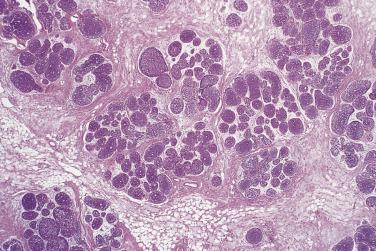
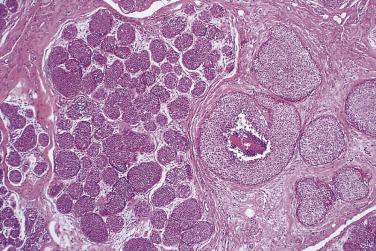
The term LCIS is somewhat of a misnomer, and it is not generally regarded as an obligate precursor of invasive carcinoma. The nature of the risk associated with LCIS has resulted in the prevailing view that this lesion should be regarded and managed as a risk factor rather than established in situ carcinoma; thus it is not regarded as, for example, requiring complete local excision with wide margins.
Lobular neoplasia, of mild or extensive degree (i.e., ALH or LCIS) is a relatively rare lesion occurring in approximately 1% of biopsies. It rarely produces a significant clinical abnormality, nor is it visible to the naked eye macroscopically. However, the apparent incidence of lobular neoplasia has increased with mammographic screening, as associated microcalcification may rarely be present.
The magnitude of risk of subsequent development of carcinoma for ALH and LCIS is comparable to ADH and DCIS—that is, a fourfold increased risk for ALH and a tenfold risk for LCIS. Because of the difference in risk between ALH and LCIS, when sufficient tissue has been sampled to enable accurate distinction (e.g., in surgical specimens), it is recommended that the lesion is subclassified as one or the other (i.e., as ALH or as LCIS). These lesions are most commonly identified in the perimenopausal age range, with a decreasing incidence with advancing age; indeed, there is evidence that the risk of development of subsequent cancer is greatest in the premenopausal period and does not remain constant over time.
There is also an interaction with a family history of breast cancer; the combination of ALH and a first-degree relative (mother, sister, or daughter) with a history of breast cancer, in some series, doubles the risk. Pagetoid extension of ALH to involve adjacent ducts (see later) increases the risk to approximately sevenfold.
Subsequent carcinomas can occur in either breast, but analyses have demonstrated that ipsilateral carcinoma is three times more frequent than contralateral disease, and some have described ALH as having a role “intermediate between a local precursor and a generalized risk for both breasts.” Others have stated, “LCIS may be a precursor rather than just an ambiguous risk factor for invasive breast cancer.”
Except for very rare circumstances where there is florid localized LCIS forming an indistinct mass, both ALH and LCIS are invisible to the naked eye. As discussed, lobular neoplasia is usually identified as a chance finding in tissue excised for another reason, although an increased incidence in mammographic breast screening program has been reported, as florid lesions may show microcalcification (see later).
Lobular neoplasia of classic type is composed of a uniform population of characteristic cells within the acini of TDLUs (see Fig. 16.44 ). Loss of heterozygosity studies show that lobular neoplasia is a clonal process. To be classified as LCIS the proliferation fills and expands, and can distort, the TDLU; in general this is defined as more than eight cells across more than half of the acini in a TDLU. Lesser degrees are defined as ALH. The lobular cells may extend to involve adjacent ducts in a pagetoid fashion, where the typical cells can be seen underlying the normal, sometimes flattened, ductal luminal epithelial cells or occasionally replacing the normal duct epithelial layer.
The cells of lobular neoplasia have a characteristic appearance resembling acinar epithelial cell, being small to moderate in size, with a regular, rounded, lightly stained nucleus and a surrounding thin rim of cytoplasm. Nucleoli are indistinct or small. Discohesion of the cells is a hallmark feature, and cell membranes are indistinct. Some cells may contain intracytoplasmic lumina, which can be helpful diagnostically, although this feature can be seen in other benign and malignant conditions. These represent mucin-filled vacuoles formed by a microvillous apical membrane and may be identified using epithelial membrane immunoreactivity or, more traditionally, a combined Alcian blue/PAS stain but can also be seen on routine H&E stains.
As noted, lobular neoplasia can extend to involve ducts, typically in a pagetoid fashion; the neoplastic lobular cells extend singularly, or in groups, beneath a preserved luminal epithelial layer of the duct. More rarely, with greater involvement, the luminal layer may be replaced, a process that may extend to complete filling of TDLUs (see Fig. 16.45 ).
Minor forms of lobular proliferation have been classified as mild ALH or typical lobular hyperplasia. Significantly, in our opinion, Page found no significant increased risk of subsequent development of carcinoma in this group; therefore we tend to ignore minor degrees of lobular epithelial proliferation. This is not, however, the case for established classic LCIS, which should be identified and reported; the large National Surgical Adjuvant Breast and Bowel Project (NSABP-P1) trial demonstrated a 56% reduction in subsequent development of invasive carcinoma in patients with LCIS who received tamoxifen as a preventative agent, highlighting the potential importance of the recognition of other than minimal lobular neoplasia.
The appearances described earlier are those of classic LCIS. Variants have more recently been described. One, pleomorphic lobular in situ neoplasia, has the same architectural appearances as the more classic forms of the disease, including the lobulocentric low-power appearances. The cells are similarly discohesive but are large and pleomorphic and have abundant eosinophilic cytoplasm and large variable nuclei, often with prominent nucleoli. A signet ring cell pattern of pleomorphic LCIS has also been described. Mitoses may be more conspicuous, and immunohistochemical assays show a higher proliferation rate and more frequent HER2 membrane reactivity than the classic form of lobular neoplasia, although, conversely, up to 11.7% of the cases have been reported to have a triple negative immunoprofile. Nevertheless, the typical chromosomal changes of lobular neoplasia, including loss of 16q, are identified.
Particularly when identified in needle core biopsy, there is significant (25%–30%) chance of there also being invasive lobular carcinoma being present in the adjacent breast, albeit in small series of pleomorphic LCIS. As this form of the disease shows more aggressive morphology and immunophenotype, there is a widespread view that pleomorphic LCIS should be regarded clinically as more akin to high-grade DCIS. Indeed, historically, this process would undoubtedly have been reported as such, and complete surgical excision with tumor-free margins is recommended. However, published series are relatively small, and the clinical behavior of this relatively uncommon form is poorly understood; further studies are required to address the behavior and management of this subtype. Another variant of pleomorphic LCIS is recognized, namely pleomorphic apocrine LCIS ; this similarly has the cytologic features of a lobular lesion in the form of discohesive intralobular cells, but these are large and pleomorphic with abundant eosinophilic cytoplasm and apocrine features.
Finally, variants of LCIS showing classic cytology but with central comedo type necrosis, also called florid LCIS or mass-forming LCIS, have been reported. The clinical behavior of these is poorly understood, but based on histologic appearance and molecular biology this is also presently considered as another, uncommon, form equivalent to pleomorphic LCIS.
Lobular neoplasia may be identified within the confines of benign lesions such as fibroadenomas, radial scars, and sclerosing adenosis. In such situations, it may be difficult to use the criteria laid down by Page to distinguish between ALH and LCIS (i.e., proportion and degree of expansion of acini in a TDLU), but judgment and distinction can often only be made on a subjective assessment of the degree of involvement. The risk attributable to ALH or LCIS involving such lesions is currently regarded as similar to that involving distinct TDLUs.
Because of the difference in risk, when sufficient tissue has been sampled to enable accurate distinction (e.g., in surgical specimens), it is recommended that the lesion is subclassified as ALH or as LCIS. The risks attributed to ALH, ALH with duct involvement, and LCIS currently are largely based on the work of Page and Dupont. Page reported a consistency of diagnosis of LCIS by using the following criteria:
The characteristic, uniform cells must comprise the entire population of cells in a lobular unit.
There must be filling (no interspersed intercellular spaces between cells) of all the acini (of the terminal duct lobular unit).
There must be expansion or distension of at least one-half of the acini in the lobular unit.
These criteria are used in the same manner to identify ALH—that is, when the features present fail to achieve the criteria for LCIS, the process should be regarded as ALH. Some groups would regard “expansion” to require a population of eight or more cells across the acinus. In ALH, in addition, the cell population may be mixed with accompanying myoepithelial cells, leukocytes, or residual acinar epithelial cells.
The most common diagnostic problem with LCIS is distinction from lobular involvement by DCIS, particularly when the latter is of low cytonuclear and grade and solid architecture ( Table 16.1 ). All forms of DCIS can extend to involve the acinar units of the TDLU, as so-called “cancerization,” although this is much more common with high-grade disease, which causes less diagnostic difficulty, other than with pleomorphic LCIS. A diagnosis of DCIS rests on the presence of characteristic histology in duct spaces that may be mirrored in the TDLU. LCIS and ALH usually appear lobulocentric and, when extending into adjacent ducts, typically do so in a pagetoid fashion. Studies have shown, however, that the reproducibility of diagnosis of pleomorphic LCIS is poor, and work on improving this is clearly required.
| Variables | DCIS | LCIS |
|---|---|---|
| CYTOLOGY | ||
| Cell cohesion | Cohesive | Discohesive |
| Cytologic atypia | May show mild, moderate, or marked pleomorphism, depending on cytonuclear grade; cancerization usually of high cytonuclear grade DCIS | Mild to moderate pleomorphism |
| Cytoplasm | Frequently amphophilic cytoplasm | Cytoplasm usually clear to eosinophilic |
| Intracytoplasmic vacuoles | Rare | Frequent |
| ARCHITECTURE | ||
| No pagetoid involvement of ducts | May show pagetoid pattern in ducts | |
| May show irregular or partial involvement of acini | Uniform involvement of acini | |
| May have a cribriform or micropapillary pattern | No cribriform spaces or micropapillae | |
| IMMUNOHISTOCHEMISTRY | ||
| E-cadherin | Positive membranous reactivity | Usually negative or weak membranous or cytoplasmic reactivity |
| P120 | Membranous | Cytoplasmic |
| β-catenin | Membranous | Typically absent, but cytoplasmic expression may be present |
Lobular neoplasia is typically discohesive, with weak or complete loss of E-cadherin. This is a calcium-dependent cell-cell adhesion molecule that can be demonstrated immunohistochemically. In difficult lesions the examination of E-cadherin immunohistochemistry may prove helpful, as weak or absent membrane E-cadherin staining is typically, but not invariably, seen in lobular neoplasia. Of note, comparison with adjacent ducts may be helpful in distinguishing cases of lobular neoplasia with weak membrane reactivity. Occasionally we have found that immunohistochemistry for other members of the E-cadherin membrane complex, such as β-catenin and p120 catenin, may be helpful in E-cadherin indeterminate cases.
Rarely, one can see a solid, regular, small cell proliferation filling and distorting ducts and involving terminal duct lobular units. In some of these instances it may be impossible to separate the differential diagnoses of small cell solid DCIS and LCIS, even with E-cadherin immunohistochemistry, which may show a mixed pattern. There are also relatively unusual cases that show features of DCIS, but with a coexisting, lobulocentric, morphologically different process with histologic features of LCIS, which appear to represent a mixed DCIS and LCIS process. Finally, there are occasional cases of low-grade solid epithelial proliferation, where the differential diagnosis lies between LCIS and DCIS, and a borderline pattern of E-cadherin staining is also seen. There thus remains a group of borderline lesions that show a mixed pattern on both routine H&E stains and E-cadherin immunostaining, and these lesions cannot be definitively categorized as LCIS or DCIS. It is our policy to report these types of lesions (i.e., both indeterminate lesions and proliferations with unequivocal features of both processes) as combined DCIS and LCIS. The logic of this approach is to infer to the clinicians that there is a risk attributable to the DCIS, which relates largely to the ipsilateral breast but also a bilateral risk attributable to LCIS.
As noted, extension of high-grade variants of DCIS into the lobules tends to present no great diagnostic difficulty in differentiation from LCIS, as the cellular characteristics are typically those of a high-grade malignant process with large cell size, frequent mitotic figures, and necrosis. The differential diagnosis is with pleomorphic LCIS; in the latter, a discohesive architectural pattern, presence of disease predominantly in lobules (rather than ducts), and negative or weak E-cadherin membrane reactivity is typically seen.
Carcinoma of the breast is the most frequent solid epithelial malignant tumor in women, although in some countries it is now equaled by carcinoma of the bronchus. It can occur at any age but is rare in patients younger than 25 years and over 80 years, particularly in the so-called developed world; the peak incidence is 45 to 60 years in this population. The incidence and mortality are high in most developed counties, especially the United Kingdom and the United States. Significantly, the frequency is also increasing, especially in younger age groups; this is not due entirely to an increase in the at-risk population. The lifetime risk for women in the Western Hemisphere is 1 in 10. Although breast cancer is rarely seen in males, it is 200 times more common in women than men.
It is conventional to subdivide carcinoma of the breast into two main pathologic categories, in situ carcinoma and invasive carcinoma; as noted in this setting the relevant precursor lesion represents DCIS rather than LCIS.
DCIS is defined as a proliferation of malignant epithelial cells within parenchymal structures of the breast and is distinguished from invasive carcinoma by the absence of microscopic stromal invasion across the limiting basement membrane.
Series from the 1930s and 1940s indicated that DCIS had a high rate of progression to invasive carcinoma; the most widely quoted series reported a 50% rate of progression to invasive disease after 3 years when DCIS was treated by biopsy alone. However, it must be borne in mind that only the large cell/comedo/high-grade subtypes of DCIS were recognized at this time. Initial reviews of the natural history of lesions originally classified as benign and treated by biopsy alone suggested lower frequencies of recurrence and progression to invasive carcinoma; approximately 20% to 30% of these patients developed invasive cancer over a period of 15 to 20 years, but progression to invasive carcinoma continued with longer follow-up, with 40% of women with low-grade (largely previously missed) DCIS developing invasive lesions by up to 30 years of follow-up.
Because of the reported high risk of progression of high-grade disease seen in early series, historically women with DCIS were treated with mastectomy; more than 95% of patients treated in this way are in essence cured. It is now evident that women with smaller foci of DCIS, such as many of those detected by mammography, can be managed by breast conserving therapy. There is a large body of research assessing and describing prognostic factors in this cohort. The features related to risk of local recurrence in patients treated by wide local excision alone (with or without radiotherapy) include adequacy of excision as well as histologic features and biology. An increased risk of recurrence of disease for patients who have undergone breast conserving surgery for DCIS is reported in those women of younger age and with symptomatic detection of the lesion, as well as certain histologic features, such as involved margins and high-grade disease, presence of necrosis, and solid growth pattern.
Recurrence of DCIS is usually at, or close to, the original biopsy site and most often shows a similar genetic profile to the primary lesion, indicating that this is residual disease. Subsequent invasive tumors also typically develop in the same breast, close to the biopsy site. This, together with three-dimensional reconstruction studies, highlights that, in contrast to LCIS, DCIS is a unifocal disease process rather than a multifocal process.
Large studies have shown that radiotherapy to the breast reduces the risk of local recurrence, but margin status in several of these series has proven problematic to quantify. More recent meta-analysis data have suggested that margins of 2 mm or more are beneficial for reduction in risk of local recurrence in patients with DCIS undergoing breast conserving surgery.
The pattern of presentation of DCIS has changed considerably. Historically DCIS presented as a palpable mass or with nipple discharge, often blood stained. The propensity of all types of DCIS to undergo microcalcification, either in the center of the duct space in association with comedo type necrosis or in inspissated secretions in cribriform spaces, allows radiologic detection as coarse or fine particulate densities, respectively, by mammography. This ability to detect DCIS via radiologically detected microcalcification has led to a substantial increase in its prevalence following the introduction of mammographic breast cancer screening. Prior to the widespread use of mammography, DCIS constituted 5% or less of cases of breast cancer. In mammographic breast screening programs its frequency rises to 20% to 25% of breast cancers detected.
Axillary nodal involvement is described in symptomatic series of DCIS at frequencies of around 1% to 2%. This usually occurs in association with extensive disease, and presumably small foci of invasive carcinoma have been missed due to the logistics and sampling of such large areas of disease. Smaller areas of DCIS are generally detected through mammographic breast screening, and thorough microscopic sampling is less challenging. In this setting, axillary node involvement in the absence of identification of a small invasive focus is exceptionally rare. For this reason, although historically surgeons have removed some or all axillary lymph nodes, this is no longer considered appropriate as standard of care. In some situations, however (e.g., when high-grade DCIS is diagnosed in a core biopsy sample associated with extensive radiologic calcification [>40 flecks]), there is an unsuspected invasive focus in approximately 50% of cases. In such cases, or when extensive high-grade DCIS requires mastectomy to achieve complete excision, some would consider sentinel lymph node biopsy appropriate because of the high risk of invasive disease that has been missed in a prior core needle biopsy.
Cases presenting symptomatically as a mass lesion may show an ill-defined area of firm fibrous tissue but often without the demarcation and solidity seen with many invasive carcinomas. DCIS with associated comedo-like necrosis, particularly if the duct spaces are dilated, may be visible to the naked eye as this soft, pale cheeselike necrotic debris can be expressed from a cut surface. However, mammographically detected disease may be entirely invisible to the naked eye. Examination of tissue may thus benefit from the use of specimen radiography to target appropriate areas for histologic examination; for this reason, surgical specimens for excision of DCIS often require more extensive sampling than for invasive tumors.
Historically DCIS was classified according to the architectural pattern. One advantage of recognizing these different patterns is that it facilitates the diagnosis of the process and that the architecture of DCIS is often related to extent of disease. There is also some evidence that the predominant architectural pattern of DCIS is of some prognostic relevance. However, there is often more than one architectural pattern present in an individual lesion, making this classification somewhat difficult to use reproducibly.
There is robust evidence that cytologically high-grade DCIS is more likely to recur than low-grade disease and to progress to invasive carcinoma, although low-grade DCIS may show long-delayed recurrence. The systems most favored for categorization of DCIS are techniques based on classification of cytonuclear grade alone (such as those recommended in the United Kingdom and United States ) or which incorporate grade with an assessment of cell organization/polarization or an assessment of a combination of grade plus necrosis. There is not one globally agreed method for classification of DCIS. Some data suggest that all methodologies are essentially similar in both distribution and in prediction of the risk of local recurrence (as either ipsilateral in situ or invasive disease).
The validity of grading of DCIS is reinforced by studies of biologic and molecular markers. High-grade DCIS is often positive for HER2 and p53 and tends to be negative for estrogen receptors, progesterone receptors, and bcl-2, with a high proliferation rate. Conversely, low-grade DCIS is typically negative for HER2 and p53; positive for estrogen receptors, progesterone receptors, and bcl-2; and has a low proliferation rate. This is similar to the relationships between these markers and grade in invasive carcinoma.
Significantly, there are also genetic differences between different grades of DCIS, indicating that these are truly different entities and that they represent different pathways to potential invasive disease. It is also relevant that, in invasive carcinomas, the cytonuclear grade of the in situ and the pleomorphism score of the invasive component typically correlate; indeed, the cytonuclear grade of DCIS, invasive tumor, any recurrent carcinoma, and subsequent metastatic disease appears to remain constant. As an example, it is exceptionally uncommon to identify low-grade DCIS with grade 3 invasive carcinoma or, conversely, high-grade DCIS with a grade 1 invasive tubular cancer.
As noted, the majority of DCIS grading systems are primarily based on cytonuclear grade and use three categories; there is considerable overlap between most classifications. The National Health Service Breast Screening Programme of the United Kingdom (NHSBSP) and the College of American Pathologists recommend using nuclear grade. This is the method we use and describe here.
Become a Clinical Tree membership for Full access and enjoy Unlimited articles
If you are a member. Log in here